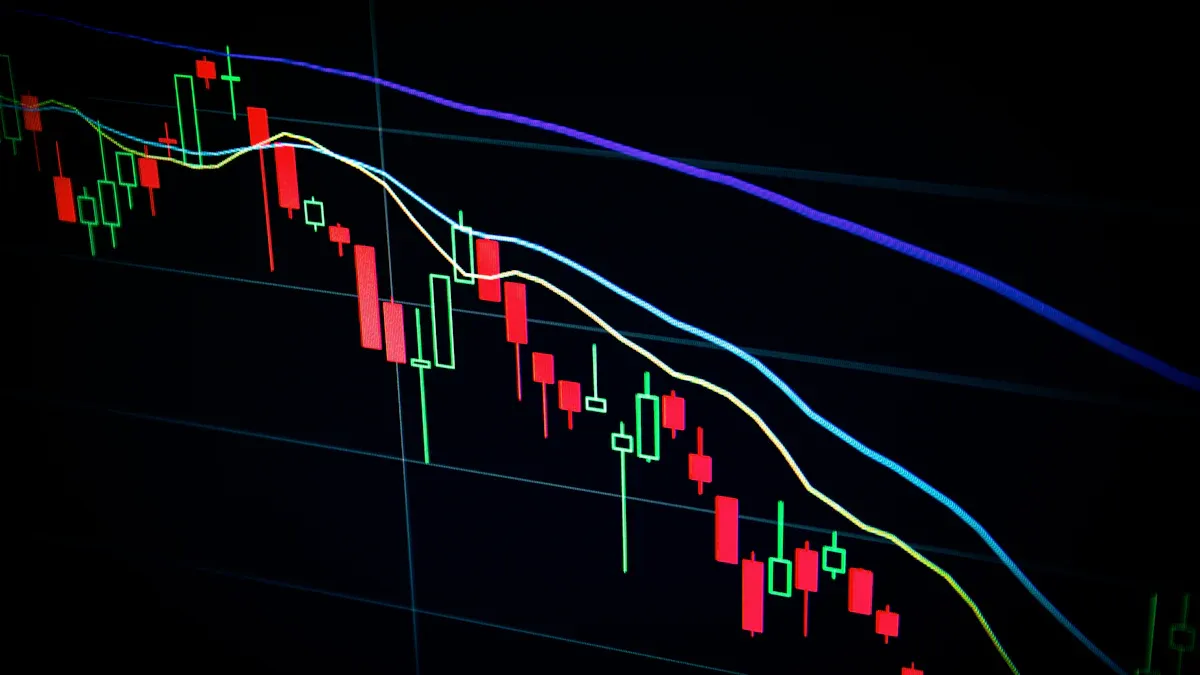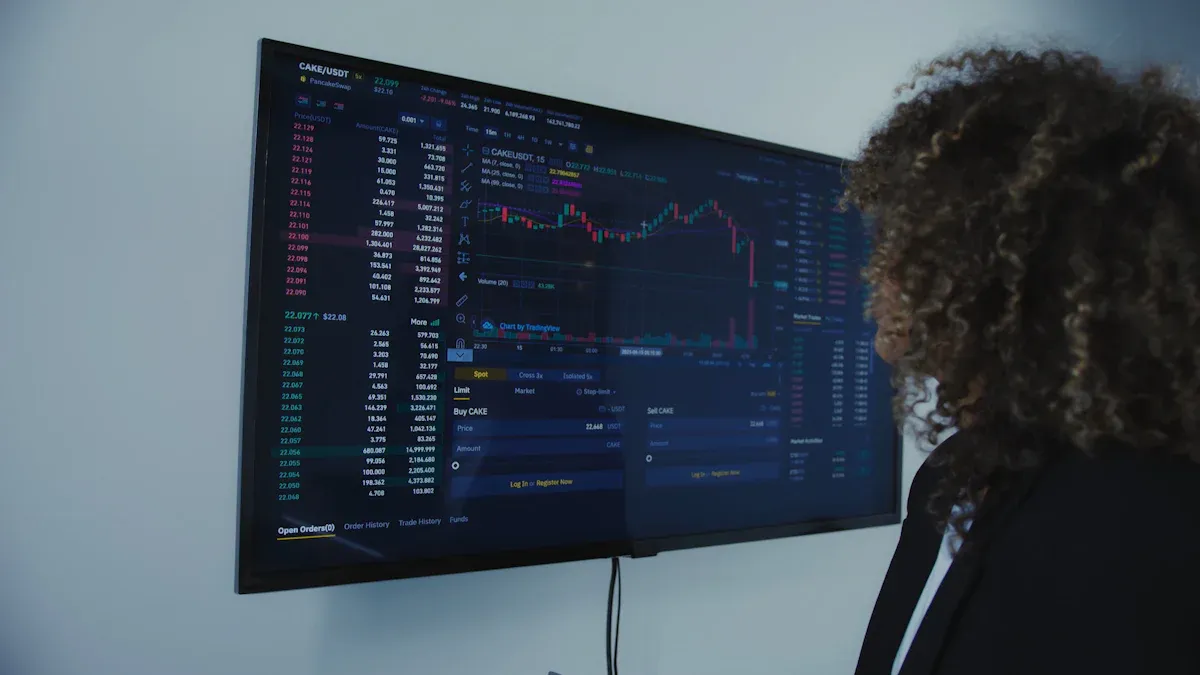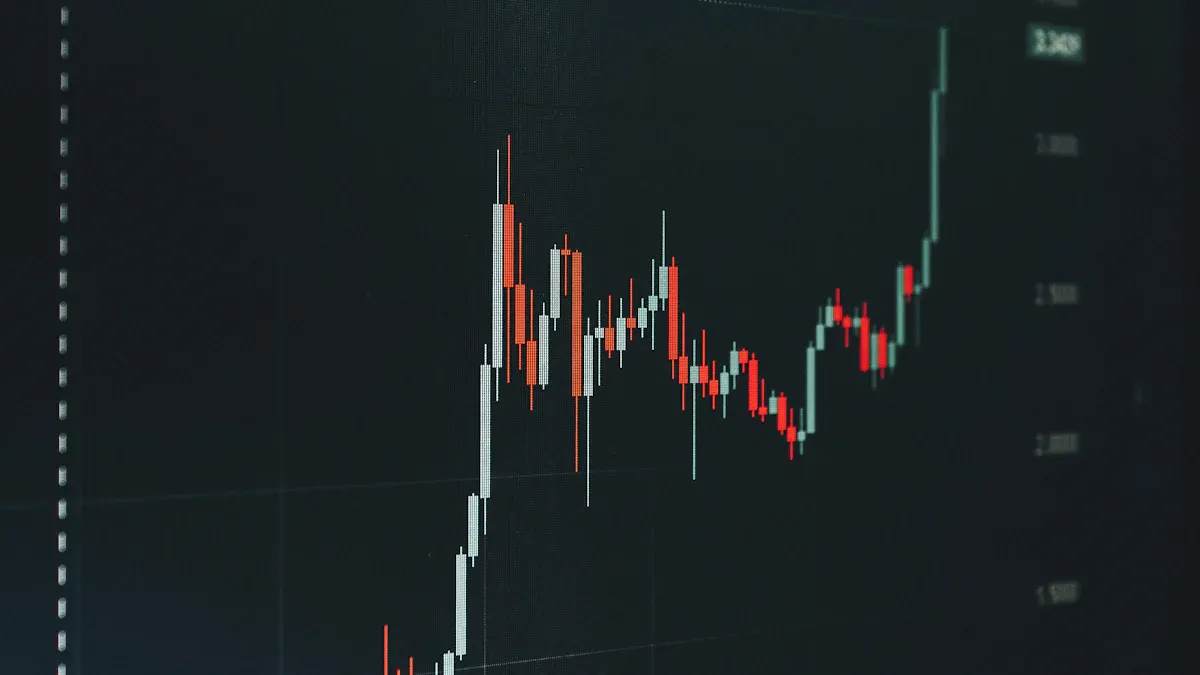- EasyCard
- Trade
- Help
- Announcement
- Academy
- SWIFT Code
- Iban Number
- Referral
- Customer Service
- Blog
- Creator
Short Covering: Key Insights into a Critical Aspect of Short Selling and Its Market Impact

Image Source: unsplash
Short covering is a core step in the short selling process. Investors borrow stocks and sell them, then repurchase the same number of shares to return to the lender, completing the position closure. When market prices rise, holders of short positions are forced to cover quickly, a mechanism that directly impacts market price fluctuations and trading activity.
Key Points
- Short covering is a critical step in short selling, requiring investors to repurchase borrowed stocks to close positions and avoid losses.
- When market prices rise, short sellers are forced to cover, creating strong buying pressure that may lead to sharp stock price increases.
- Short covering is closely linked to market volatility, and concentrated covering can exacerbate price fluctuations, potentially triggering short-term bubbles.
- Investors should monitor the short interest ratio, manage position sizes appropriately, and set stop-loss orders to reduce risks.
- Historical cases like the GameStop event show that short covering can rapidly alter market supply and demand dynamics, affecting overall market sentiment.
Definition of Short Covering

Image Source: pexels
Principles of Short Selling
Short selling is a strategy where investors borrow stocks and sell them on the market, expecting to repurchase them at a lower price in the future. Investors typically borrow stocks from brokers and sell them at the current market price.
- Borrow securities and sell them at market price, hoping the stock price will fall for a later repurchase.
- The core of short selling lies in the investor bearing the risk of price increases.
- Short covering is a necessary step in short selling, as investors must repurchase the borrowed securities to return them to the lender to close the short position. This mechanism is particularly common in the U.S. market, where investors need to closely monitor price changes to control potential losses.
Mechanism of Short Covering
Short covering refers to short sellers repurchasing previously borrowed and sold stocks to return them to the lender, completing the transaction cycle. The process is as follows:
- Borrow stocks: Investors borrow stocks from a broker for short selling.
- Sell on the market: Investors sell the borrowed stocks on the open market, expecting the stock price to fall.
- Monitor stock prices: Investors continuously track stock price changes to decide when to repurchase.
- Repurchase stocks: If the stock price rises, investors may need to repurchase stocks at a higher price to close the position.
- Return stocks: The repurchased stocks are returned to the lender, completing the transaction.
- Address margin requirements: If the stock price rises excessively, investors may receive margin calls, requiring them to purchase stocks or add funds to meet margin requirements.
In the U.S. market, short covering is often triggered by rapid stock price increases. Many traders holding short positions are forced to repurchase stocks to limit losses, and this buying pressure further drives up prices, creating a self-reinforcing cycle.
- When stock prices rise, short sellers are forced to buy to limit losses.
- The power of short covering lies in its self-reinforcing nature: rising prices prompt more short sellers to close positions, and buying pressure pushes prices higher.
- This mechanism can lead to significant market volatility in the short term, even explosive price surges.
Short covering is not only a key step in short selling but also a major driver of market price fluctuations. Investors must closely monitor market dynamics, assess risks rationally, and ensure transaction safety during operations.
Role and Triggers of Short Covering
Analysis of Key Steps
Short covering plays a critical role in short selling. Whenever investors choose to short sell, they must ultimately repurchase stocks to close the position. This process not only determines the profit or loss of the short sale but also directly impacts the market’s supply and demand structure.
- Short sellers face greater covering pressure when market prices rise, requiring them to repurchase stocks at higher prices, leading to increased losses.
- When the proportion of short positions exceeds long positions in the market, any rapid price increase may trigger large-scale short covering, forming a strong buying wave.
- Concentrated short covering exacerbates market price volatility, becoming a core driver of sharp short-term price increases.
Trigger Causes
Short covering in the market is typically closely tied to rapid price increases. The following factors are common in the U.S. market:
- When stock prices rise rapidly, short sellers are forced to repurchase stocks to limit losses.
- This covering behavior creates a feedback loop, further driving up prices.
- High short interest (e.g., short interest exceeding 20%), positive news, or unexpected large-scale buying can serve as triggers.
- When stock prices rise to a certain level, short sellers may receive margin calls, forcing them to repurchase stocks to return borrowed shares.
Relationship with Short Squeeze
Short covering is closely tied to short squeezes.
- Short covering is a key component of a short squeeze.
- When short sellers repurchase stocks to close positions, it creates upward pressure on stock prices.
- This dynamic leads to rapid stock price increases, with short sellers rushing to exit positions, increasing market volatility.
- During a short squeeze, short sellers’ buying behavior further drives up prices, forming a self-reinforcing upward cycle.
Impact of Short Covering

Image Source: unsplash
Market Price Changes
Short covering directly drives rapid market price increases. When investors cover short positions, they need to buy large quantities of stocks in the market, significantly increasing stock demand.
- Short-term covering typically occurs when investors buy stocks to close positions, leading to a short-term surge in market demand and rising prices.
- When many traders hold negative views on a stock and concentrate on short selling, a shift in market sentiment can lead to simultaneous short covering, with demand far exceeding supply, causing sharp price increases.
- As prices continue to rise, brokers issue margin calls to short sellers, forcing them to repurchase stocks to prevent further losses. This passive buying further accelerates price increases, potentially leading to parabolic price movements.
Short-term covering not only affects individual stocks but may also impact entire market sectors. The U.S. market has repeatedly seen rapid price reversals due to short covering, becoming a focal point of market attention.
Volatility and Bubbles
Short covering is often accompanied by significant market volatility, potentially forming short-term market bubbles.
- Academic research indicates that the presence of short-term short positions creates asset repurchase demand, driving price increases and forming short-term bubbles. Short selling plays a complex role in both suppressing and fueling bubbles.
- News reports show that in the GameStop event, concentrated buying by retail investors forced short sellers to repurchase stocks at higher prices, creating a typical feedback loop with prices soaring dramatically in a short period.
| Evidence Type | Content |
|---|---|
| Academic Articles | The presence of short-term short positions leads to asset repurchase demand, driving price increases and forming short-term bubbles. The complex role of short selling in suppressing and fueling bubbles is widely discussed. |
| News Reports | The GameStop case demonstrated how short selling triggered price surges, with retail investors’ buying behavior forcing short sellers to repurchase stocks at higher prices, forming a feedback loop. |
Short-term covering activities are strongly correlated with market volatility during extreme events, particularly in small-cap stocks. Short covering not only exacerbates price increases but also increases overall market volatility.
Investor Behavior
Short covering has a profound impact on investor behavior and market sentiment.
- Behavioral finance theory suggests that investors often overreact or follow trends due to news, market sentiment, or cognitive biases, leading to short-term market price distortions. Skilled investors can identify and capitalize on these behavioral fluctuations, seizing short-term opportunities before market corrections.
- Market noise theory indicates that noise traders operate based on noisy signals, further exacerbating market inefficiencies and volatility.
- In the U.S. market, the GameStop event showed that sentiment-driven activities on social media can significantly influence market sentiment and prices, with short squeezes causing investor sentiment fluctuations that affect long-term investors’ decisions.
| Short Seller Behavior | Impact | Description |
|---|---|---|
| Contrarian Traders | Stabilize Prices | Short sellers exhibit contrarian trading characteristics during extreme price volatility, helping reduce the risk of stock price crashes. |
| Sentiment Influence | Correct Mispricing | In emerging markets dominated by individual investors, sentiment is a key factor in short sellers regulating market crashes. |
| Support Buyers | Reverse Market Sentiment | Short sellers act as “support buyers” during sudden market declines, reversing previous optimistic sentiment. |
When short covering events occur frequently, market activity significantly increases, and investor trading behavior becomes more frequent. Some investors exploit short-term market misalignments for arbitrage, while others adjust investment strategies due to sentiment fluctuations. Overall, short covering not only affects price trends but also profoundly alters market participants’ behavior patterns.
Short Covering Cases
Historical Events
Global financial markets have repeatedly experienced significant volatility due to short covering. Two of the most representative events occurred in 2008 and 2021. The table below summarizes the core information of these two events:
| Event | Year | Description |
|---|---|---|
| GameStop | 2021 | GameStop’s short covering became a cultural phenomenon, with retail investors driving stock price increases through social media, causing significant losses for institutional short sellers. |
| Volkswagen | 2008 | Volkswagen’s short covering was triggered by Porsche increasing its stake, leading to a stock price surge and substantial losses for short sellers. |
In the GameStop event, retail investors rallied on social platforms, collectively buying high short-interest stocks, forcing institutional investors to cover positions at prices far above their short prices. The Volkswagen event was triggered by Porsche’s sudden announcement of a significant increase in its stake, sharply reducing the number of shares in circulation, forcing short sellers to buy back stocks at high prices, causing a rapid stock price surge.
Market Performance
Short covering events typically trigger extreme market price volatility. GameStop’s stock price in January 2021 surged from less than USD 20 to over USD 400, a more than 20-fold increase in a short period. Volkswagen in 2008 also saw its stock price rise from approximately USD 210 to nearly USD 1,000 in two days due to short covering, making it one of the highest-valued companies globally at the time.
These events highlight the significant impact of short covering on market supply and demand dynamics.
- Short sellers are forced to buy during rapid price increases, creating strong buying pressure.
- Market liquidity drops sharply, significantly amplifying price volatility.
- Institutional investors, unable to cover in time, suffer substantial losses, with some hedge funds even facing liquidation risks.
These historical cases remind investors that short covering can not only drive significant short-term stock price increases but also trigger structural market risks. Investors trading high short-interest stocks should closely monitor market dynamics and rationally assess potential risks.
Risks and Strategies
Risk Assessment
Short covering poses multiple risks for investors, particularly during periods of high market volatility. Key risks include:
- Potential for unlimited losses: When borrowed stock prices continue to rise, short investors’ losses are theoretically unlimited.
- Market trend impact: The U.S. stock market generally trends upward over the long term, putting short sellers at a systemic disadvantage.
- Short squeeze: When stock prices surge suddenly, short investors are forced to buy in bulk, further driving up prices.
- Margin risk: When stock prices rise too quickly, brokers issue margin calls, requiring investors to add funds or face forced liquidation.
Investors can assess potential risks through the short interest ratio.
- The short interest ratio reflects the concentration of short positions in the market, with higher values indicating more investors are bearish on the stock.
- Stocks with high short interest ratios are more prone to short squeezes during market sentiment shifts, leading to sharp price volatility.
Traders should closely monitor short interest ratios and market sentiment changes to identify potential short covering risks promptly.
Strategy Recommendations
Investors can adopt several strategies to mitigate risks associated with short covering:
- Manage position sizes appropriately: Set appropriate position sizes for each short position based on stock volatility, market conditions, and personal risk tolerance to avoid excessive risk from a single stock.
- Set stop-loss orders: Predefine stop-loss prices to automatically close positions if the market moves unfavorably, limiting losses.
- Diversify investment portfolios: Spread short positions across different stocks or industries to reduce the impact of sharp price fluctuations in a single stock on the overall portfolio.
- Continuous risk assessment: Regularly evaluate market risks, monitor emerging risk factors, and adjust trading strategies promptly.
- In-depth market analysis: Combine fundamental and technical analysis to identify market trends and potential reversal signals.
- Monitor news and information flows: Stay updated on market dynamics and major events to flexibly adjust short strategies.
| Strategy Type | Specific Measures | Purpose |
|---|---|---|
| Position Management | Control single position size | Reduce loss risks from extreme volatility |
| Stop-Loss Mechanism | Set automatic stop-loss orders | Limit uncontrollable losses |
| Investment Diversification | Spread investments across multiple stocks or industries | Stabilize overall portfolio performance |
| Information Monitoring | Track market news and data | Respond promptly to sudden market changes |
Scientific risk management and strategy formulation help investors navigate uncertainties caused by short covering in the U.S. market, enhancing transaction safety and stability.
Short covering plays a decisive role in short selling, directly affecting market prices and volatility. Investors should focus on the following risk factors:
| Risk Factor | Description |
|---|---|
| Capital Requirements | Significant capital is needed to cover potential losses. |
| Liquidity Shortages | Low market liquidity makes it difficult to cover positions at ideal prices. |
| Unexpected Market Events | Economic news or company changes may lead to sharp price fluctuations. |
Investors can effectively address uncertainties from short covering through risk assessment, transparent communication, and detailed response strategies.
FAQ
What is short covering?
Short covering refers to investors repurchasing the same number of stocks in the market after short selling to return the borrowed stocks, thereby closing the short position.
Can short covering cause stock prices to surge?
When many short sellers cover simultaneously, market buying pressure surges, potentially causing stock prices to rise sharply in a short period, forming a so-called “short squeeze.”
How do short sellers determine the timing for covering?
Short sellers typically monitor market price trends, short interest ratios, and news events to assess risks promptly and choose the appropriate time to cover to control losses.
What is the relationship between short covering and margin calls?
If stock prices rise too quickly, brokers issue margin calls to short sellers. Short sellers must add funds or cover positions to prevent further losses in their accounts.
Is short covering common in the U.S. market?
The U.S. market has strong liquidity and active short selling. Short covering events occur frequently, especially in stocks with high short interest.
You now have a deep understanding of the short covering mechanism and its dramatic impact on market prices. When engaging in short selling or exploiting potential short squeeze opportunities, rapid capital turnover and minimal transaction costs are crucial for precise timing amidst volatility. When prices rise, short sellers must cover quickly; any delay in funds can lead to margin risks or a missed optimal closing point.
Traditional cross-border fund management and high trading fees can obstruct your ability to execute strategies precisely in high-risk trades. You need a platform that supports millisecond responsiveness and high-efficiency fund transfers across global markets.
BiyaPay is your high-volatility trading safeguard. We offer real-time exchange rate inquiry and conversion for fiat currencies, with remittance fees as low as 0.5%, and zero commission for contract limit orders, helping you maximize cost control and limit potential losses. BiyaPay allows you to seamlessly convert between various fiat and digital currencies, and trade global markets, including Stocks, all on one platform. There is no need for a complex overseas account, and you can enjoy same-day remittance and arrival. Click the Real-time Exchange Rate Inquiry now, and BiyaPay for quick registration, and use peak capital efficiency and low costs to navigate the short selling and covering dynamics securely!
*This article is provided for general information purposes and does not constitute legal, tax or other professional advice from BiyaPay or its subsidiaries and its affiliates, and it is not intended as a substitute for obtaining advice from a financial advisor or any other professional.
We make no representations, warranties or warranties, express or implied, as to the accuracy, completeness or timeliness of the contents of this publication.




Contact Us
Company and Team
BiyaPay Products
Customer Services
is a broker-dealer registered with the U.S. Securities and Exchange Commission (SEC) (No.: 802-127417), member of the Financial Industry Regulatory Authority (FINRA) (CRD: 325027), member of the Securities Investor Protection Corporation (SIPC), and regulated by FINRA and SEC.
registered with the US Financial Crimes Enforcement Network (FinCEN), as a Money Services Business (MSB), registration number: 31000218637349, and regulated by FinCEN.
registered as Financial Service Provider (FSP number: FSP1007221) in New Zealand, and is a member of the Financial Dispute Resolution Scheme, a New Zealand independent dispute resolution service provider.


















